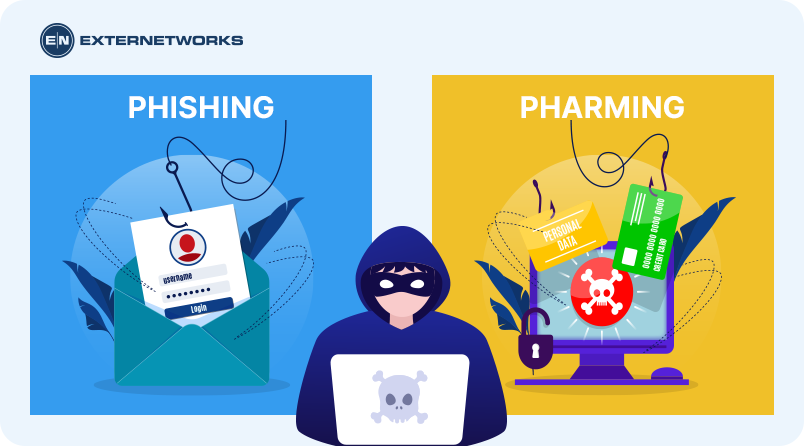28.4k views
Phishing and pharming are two cyber theft terms that describe malicious attempts to steal personal information or infect computers with malware.
Phishing is a type of social engineering where criminals send emails pretending to be from legitimate companies or individuals. They often contain malicious links to websites that look real but are designed to trick you into giving away sensitive information. Pharming is hackers who attempt to access your computer using software installed on your device.
Phishing and pharming scams are becoming more sophisticated every day, and they often target individuals looking for ways to improve their financial situation or personal life. What exactly does each term mean? How do you stay safe from these types of attacks?
Phishing involves sending emails to unsuspecting users claiming to be from legitimate businesses. These emails contain links to fake websites designed by hackers to appear similar to those of actual companies. Clicking on these links may allow attackers to access your online accounts.
Many of these scams involve using software or security vulnerabilities. Malicious software is installed in the device of the targeted individual.
The best way to protect yourself from phishing scams is to avoid opening suspicious emails and never give out any personal information over the phone. If you receive an email with a link, it should always be opened with caution.
If a scammer has tricked you, report it immediately so that others don’t fall victim to the same thing.
If you think that you may have fallen victim to a phishing scam, contact your bank directly to see if there is anything unusual going on. Banks will often send alerts to customers if they detect unusual activity on their accounts.
Phishing attacks are common because they’re easy to execute and don’t require any technical expertise. They’re also effective at catching people off guard, so educating yourself about what makes them tick is important. Here are some examples of phishing scams:

Pharming is a form of scaming where hackers send out malicious code disguised as legitimate content from trusted sources. They goal is steal login credentials, take control of computers, or redirect people to malicious sites or authentic link. It’s usually spread through spam messages sent by infected machines.
Make sure you only visit trusted websites. Hackers sometimes disguise themselves as trustworthy websites to trick people into downloading malicious software.
Never open attachments from unknown sources. Always scan files before opening them.
Always check URLs before entering sensitive information. Report any suspicious behavior on your computer. Your antivirus program might already be doing this automatically.
Pharming attacks are one of the most common types of phishing attacks. Pharming will use techniques like DNS hijacking, DNS spoofing, and DNS cache poisoning. Phishing depends on the DNS server to redirect users to fraudulent websites.
They involve tricking people into visiting malicious websites using an email message link. These sites then redirect victims to another site where they are tricked into entering their login details. Once logged in, the attacker can steal sensitive information from the victim’s computer.
Both phishing and pharming attacks involve tricking people into revealing sensitive information. In both cases, hackers send out malicious emails that contain links to fraudulent websites. These sites then ask users to provide sensitive information, such as usernames and passwords, credit card details, or bank account numbers.
Phishing attacks use bait like fake links, while pharming attacks negotiate with the Domain Name System (DNS) servers to divert user requests to a simulated site. Once the attacker has launched a successful DNS attack, it diverts the basic stream of web browsing activity to the simulated site.
Phishing uses spoofing, SMS phishing, Fax phishing, and Vishing. These are data theft techniques that cause many organizations to suffer while Pharming involves using techniques like DNS hijackings, DNS caching poisonings, and DNS spoofing.
Pharming is trick than phishing because it attacks the DNS level, which makes it hard to detect. But phishing continues to be the top social engineering scam among consumers.
It’s essential to keep your software updated.
You need to be secure your website by using HTTPS.
Make sure that your employees undergo the appropriate cyber security training to identify potential threats and then to take action against them.
Keep an eye out for any suspicious activity by tracking how your brand is being represented online and avoid clicking on the link if you notice anything unusual.
Check online if you don’t know what version of Windows or macOS you’re running. Also, avoid clicking on authentic links in emails or messages from people you don’t trust. Finally, never share personal details, bank details, or any sensitive information.
A phishing email looks legitimate from a trusted company, but it’s trying to trick you into giving away sensitive information. In contrast, spear phishing is a targeted attack where hackers send out malicious emails aimed explicitly at a user or group of people. These emails may contain links or attachments that appear to come from a trusted source. If you click on them, you could infect yourself with malware or handing over valuable information.
Phishing and pharming scams are becoming increasingly common. Report the incident to your local law enforcement agency or Internet service provider if you’ve been targeted. Don’t hesitate to share what happened. Hopefully, this will help others stay safe while surfing the web.
There are many phishing attacks, but they all share one thing: They’re all designed to trick people into giving away sensitive information. If you receive any suspicious emails, report them immediately by clicking on the “Report Spam” button at the bottom of the message. This will alert Google so it can block future attempts from reaching your inbox.
